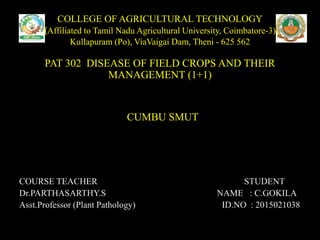
Cumbu Smut of Pearl Millet
- 1. COLLEGE OF AGRICULTURAL TECHNOLOGY (Affiliated to Tamil Nadu Agricultural University, Coimbatore-3) Kullapuram (Po), ViaVaigai Dam, Theni - 625 562 PAT 302 DISEASE OF FIELD CROPS AND THEIR MANAGEMENT (1+1) CUMBU SMUT COURSE TEACHER STUDENT Dr.PARTHASARTHY.S NAME : C.GOKILA Asst.Professor (Plant Pathology) ID.NO : 2015021038
- 2. Cumbu smut or Bajra smut • Moesziomyces penicillariae (Vanky 1977) • Syn : Tolyposporium penicillariae Bref (Berfield 1895)
- 3. Occurance History • The disease reported from Pakistan, several parts of Africa and the USA. • The earliest reports of this disease are from Senegal by Chevalier 1931. • In India it was first reported by Ajrekar and Likhite (1933).
- 4. Geographical distribution World • Smut disease has been reported in Burkina, Faso, Cameroon, Gambia, Ghana, India, Malawi, Mozambique, Niger, Nigeria, Pakistan, Senegal, Sierra Leone, Sudan, the UAS, Zambia and Zimbabwe (Peregrine and Siddiqui 1972, Rachie and Majmudar 1980 and Rothwell 1983)
- 5. India • Haryana, Punjab, Gujarat, Rajasthan, Maharashtra, Andhra Pradesh and Tamil Nadu.
- 7. Significance Economical • In India a survey during 1950s indicated that smut severity in farmers field ranged from 1 to 30% in parts of Tamil Nadu, Andhra Pradesh and Maharashtra (Rachie and Majmudar 1980). • In 1971 Bhowmik and Sundram reported that 50 to 70% of the crops infected by smut with damage upto 100% in individual panicle.
- 8. • According to annual reports f All India Coordinated Millet Improvement Programme (AICMIP) the disease has become more important in northern India particularly in the states of Haryana, Punjab, Gujarat and Rajasthan. • The increased severity due to commercial cultivation of hybrids. • In general 5-20% of grain losses have been reported.
- 9. Symptoms • The infected florets, ovaries are converted into structures called sori. • The sori larger than grains and appear as enlarged. • Initially the sori are bright green but later they turn brown to black. ©http://www.icrisat.org
- 12. • The sori are usually 3-4 mm long and 2-3 mm broad at the top. • They are covered by a thin membrane which often breaks at maturity to release brown to black sporeballs. • Infection may involve a light scattering of sori among grain on panicles up to complete coverage.
- 13. • In panicle having poor head exsertion. • The lower portion covered by fag leaf is heavily infected with smut.
- 14. Pathogen • Moeziomyces penicillariae (Vanky 1977) • Syn : Tolyposporium penicillariae Bref (Berfield 1895)
- 15. Systamatic position Kingdom : Fungi Phylum : Basidiomycotina Class : Basidiomycetes Order : Ustilaginaceae Genus : Moesziomyecs Species : penicillariae
- 16. Pathogen characters • The teleutospores occurs in compact, ball like mass cells called sporeballs. Sporeballs vary in shape from circular to near polyhedral. • The number of teleutospore aggregated in balls varies from 200 to 1400. • Individual teleutospores do not separate readily and are mostly angular to round, light brown.
- 18. • The morphology of the pathogen has been described by Maudkur and Thirumalachar (1952), Ramkrishnan (1971), Vanky (1977), Subba Rao and Thakur (1983) and Chahal et al (1986).
- 19. ©http://www.icrisat.org • The promycelium is four celled and forms both lateral and terminal sporidia. • Sporidia are produced on branched hypae in chain. • Sporidia are hyaline, one celled and spindle shaped
- 21. Life cycle • The pathogen is soil borne. The primary inoculum consist of spore balls that have fallen on the ground. • Teleutospores germinate following rain showers and produce numerous air bron sporidia that infect the pearl millet at flowering stage. • Time from inoculation to spore production is 2 weeks and sori mature within 3-4 weeks.
- 23. • Matured sori ruptured to release masses of sporeballs which under favourable weather condition. • These sporidia can infect late planted crops in near by field or panicles of late tillers of same field.
- 24. Mode of spread • Primary spread by soil. The sporeballs survive in soil. • Secondary spread by air borne smut spores.
- 25. Favourable conditions • High humidity. • Temperature between 25-35ºC is optimum for disease development. • Slightly acidic soil favour for disease development.
- 26. Integrated disease management • Breeding of smut resistant open pollinated varieties through recurrent selections has shown promise. Two population varieties developed at ICRTSAT center that is ICML 82131, ICM 82132 and two synthetics ICMS 8282, ICM 8283 have shown a high level of resistance to smut. • Smut tolerant varieties are WC-C 75, CM 46 and MBH 110 .
- 27. • Removal of affected smutted ears and burnt it. • Use clean seeds for avoid the smut disease. • Hot weather maintain to avoid the smut disease. • Provide deep ploughing in field.
- 28. • Field sanitation is important. • Provide crop rotation. • Intercropping of mungbean with pearl millet reduces smut incidence.
- 29. • The leaf extract of Eucalyptus obliqua @ 30% gave maximum growth inhibition of the fungus (9.00 mm) followed by Datura stramonium (15.0 mm) while the mixed extract of Zingiber officinale + Allium sativum was found least effective (39.50 mm) and maximum growth was recorded in Control (62.5 mm). • Eucalyptus leaf, Datura leaf, and Azadirachta extracts @ 20% also inhibited the fungal growth and were significantly superior over the other tested extracts.
- 30. • Seed treatment with carboxin 2g/kg of seed or carbendazim/Thiram/Capton 4g/kg of seed. • Hexaconazole, propiconazole and carboxin @ 0.1 percent absolute inhibition the smut fungal growth. • Spray of fungicide such as carboxin and captafol at boot stage has been recommended.